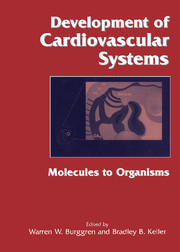Book contents
- Frontmatter
- Contents
- List of contributors
- Foreword by Constance Weinstein
- Introduction: Why study cardiovascular development?
- Part I Molecular, cellular, and integrative mechanisms determining cardiovascular development
- 1 Genetic dissection of heart development
- 2 Cardiac membrane structure and function
- 3 Development of the myocardial contractile system
- 4 Vasculogenesis and angiogenesis in the developing heart
- 5 Extracellular matrix maturation and heart formation
- 6 Endothelial cell development and its role in pathogenesis
- 7 Embryonic cardiovascular function, coupling, and maturation: A species view
- 8 Hormonal systems regulating the developing cardiovascular system
- Part II Species diversity in cardiovascular development
- Part III Environment and disease in cardiovascular development
- Epilogue: Future directions in developmental cardiovascular sciences
- References
- Systematic index
- Subject index
3 - Development of the myocardial contractile system
from Part I - Molecular, cellular, and integrative mechanisms determining cardiovascular development
Published online by Cambridge University Press: 10 May 2010
- Frontmatter
- Contents
- List of contributors
- Foreword by Constance Weinstein
- Introduction: Why study cardiovascular development?
- Part I Molecular, cellular, and integrative mechanisms determining cardiovascular development
- 1 Genetic dissection of heart development
- 2 Cardiac membrane structure and function
- 3 Development of the myocardial contractile system
- 4 Vasculogenesis and angiogenesis in the developing heart
- 5 Extracellular matrix maturation and heart formation
- 6 Endothelial cell development and its role in pathogenesis
- 7 Embryonic cardiovascular function, coupling, and maturation: A species view
- 8 Hormonal systems regulating the developing cardiovascular system
- Part II Species diversity in cardiovascular development
- Part III Environment and disease in cardiovascular development
- Epilogue: Future directions in developmental cardiovascular sciences
- References
- Systematic index
- Subject index
Summary
During the course of maturation the developing heart is subjected to variations in hemodynamic load and in the availability of oxygen and other substrates, so it is not surprising that the constituents responsible for the force generated during myocardial contraction will vary as well. The investigation of contractile protein variation during cardiac development has focused on qualitative and quantitative changes in protein isoforms. Information is also emerging about the regulatory signals that control these processes. However, much remains unknown about the functional consequences of the shifts in cardiac contractile proteins that occur with development. This chapter will outline the developmental changes in the contractile apparatus that mediate the cellular mechanics of contraction.
Mechanisms for diversity in contractile protein isoforms
The protein content of the myofibril in general reflects the transcript levels for individual proteins. Variation in myofibril composition during development is mediated by two mechanisms: alternative splicing of transcripts or differential expression of members of a multigene family (Andreadis, Gallego, & Nadal-Ginard, 1987; Nadal-Ginard et al., 1991; Chien et al., 1993; Sartorelli, Kurabayashi, & Kedes, 1993). For example, alternative splicing of transcripts regulates the troponin T (TnT) isoforms in the developing heart and determines the tissue-specific isoforms of the cc-tropomyosin (a-TM) gene (Nadal-Ginard et al., 1991). The transcriptional regulation of contractile protein genes in the heart is the subject of active investigation. A few general themes have emerged from the study of the transcriptional regulation of these genes. First, although some regulatory elements may be shared between skeletal muscle and heart, the regulatory regions controlling gene expression in heart are often distinct from those regulating expression in skeletal muscle.
- Type
- Chapter
- Information
- Development of Cardiovascular SystemsMolecules to Organisms, pp. 27 - 34Publisher: Cambridge University PressPrint publication year: 1998



